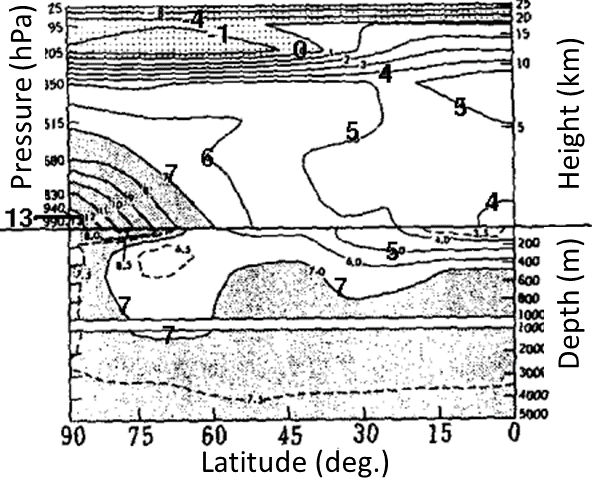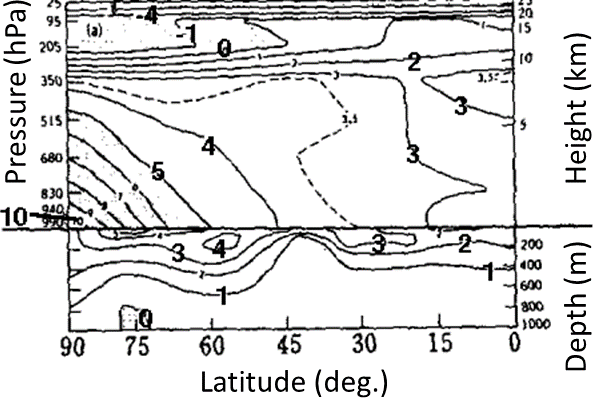Climate change
Delay due to oceanic heat capacity
Numerical experiment with an ocean-atmosphere coupled climate model
in idealized condition [Spelman and Manabe, 1984]
Setting of experiments
Idealized geography, symmetric w.r.t equator. No seasonal cycle.
- A: Standard exp. Present CO2 concentration (300 ppm) is kept.
Look at the quasi-steady state.
- B: Steady-state response exp. 4-times the present CO2 concentration (1200 ppm) is kept.
Look at the quasi-steady state.
Difference "B - A" is considered as "steady-state response
to CO2 quadrupling".
(From experience of previous numerical experiments,
response to 4xCO2 is nearly twice of response to 2xCO2.
The authors used larger forcing in order to make signals more visible.)
- C: Transient response exp. to step-like forcing.
At one time in the quasi-steady-state of A,
CO2 concentration is quadrupled suddenly, and kept at the new level.

The result of C generally looks like
approaching the state of B according to an exponential function of time (with a negative coefficient).
Result: Meridional (South-North) - vertical section of temperature difference
B (steady state exp.) - A (standard exp.)

- Stratosphere cools.
- Troposphere and ocean warm.
- In troposphere, the lower part in high latitudes warms strongly. Because ...
- In cold climates, "near-surface temperature inversion" (dT/dz > 0) is often observed.
In warmer climates, this situation occurs less often.
- There are less snow and sea ice in warmer climates. (Ice-albedo feedback)
- Warmer climates have more condensation of water vapor, resulting in smaller lapse rate (-dT/dz).
- (These facts already appear in Manabe & Wetherald 1975, where
just the heat capacity of the mixed layer (~100 m) was considered as the ocean's role.)
- The upper ocean warms toghether with the troposphere at the same latitude.
- The deep ocean warms together with the lower troposphere in the high latitude, where the sinking water forms.
Result: Meridional (South-North) - vertical section of temperature difference
C (25 years after CO2 quadrupling) - A (standard exp.)

- Temperature of deep ocean hardly changes yet in 25 years.
- Temperature changes in the atmosphere and the upper ocean
is similar to the steady-state response,
and the magnitude is approx. 70 % of s.s.r.
The delay of global warming due to ocean heat capacity
can be approximated by a linear model
with a time constant corresponding to
the heat capacity of the upper ocean
(the part of ocean where wind-driven circulation dominates).
The time series can be approximated by an exponential function
tending to the new steady state.
A rough estimate of future temperature can be made
by giving a realistic scenario of CO2 concentration
to the linear model.
(More detailed estimate will be done by
giving such a CO2 concentration scenario
to coupled 3-dimensional climate models.
2019-June-06
MASUDA Kooiti



